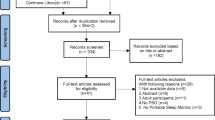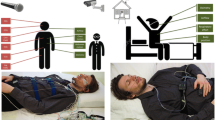Abstract
The Otorhinolaryngologist (ENT) frequently has to deal with OSA or suspicious OSA patients and undergone polysomnography (PSG) or portable monitoring (PM) and should be confident about the quality and consistency of the polysomnographic diagnosis. The main polysomnographic traces compressed in a unique epoch, defined as compact PSG/PM (CP), could represent an efficient tool to confirm the quality of PSG/PM Sleep Breathing Disorders diagnosis. This is a validation’s study of a CP interpretation’s method, analyzing the learning curve, the level of diagnostic accuracy, and the inter-operator agreement in interpreting the CP pattern between a group of ENT specialists not skilled in PSG/PM scoring, but managing SBD patients during daily practice. Seven ENT specialists have been enrolled in the study. 50 CP traces (ranging from normal to all main SBD patterns) have been showed to each participant for the interpretation and scoring process, before and after a 2-h theoretical–practical interactive lesson, focusing on the recognition of the four main oximetric patterns on CP traces (normal, phasic, prolonged, and overlap patterns). Results: before and after the theoretical–practical interactive lesson, the whole diagnostic accuracy in interpreting the 50 CP has been reported improved from 0.12 to 0.80 (median 0.52) to 0.82–0.96 (median 0.92) (p = 0.006) and the inter-scorers’ agreement showed a kappa value increased from of 0.18 to 0.75 (p < 0.0001). A complete clinical diagnostic evaluation is essential in OSA patients and the ENT specialist should be concerned to verify if the patient, suitable for surgical therapy, is affected really by an isolated form of OSA. The CP interpretation allows a checking of the proper nosographic SBD framework and could be significantly important for all ENT specialists not skilled in PSG/PM scoring, but managing SBD patients during daily practice. The data reported in our validation’s study showed that the CP interpretation’s method is easy to apply, with a rapid learning curve. The level of diagnostic accuracy is high with a high inter-scorer agreement in interpreting the CP patterns.



Similar content being viewed by others
References
Peppard PE, Young T, Barnet JH, Palta M, Hagen EW, Hla KM (2013) Increased prevalence of sleep-disordered breathing in adults. Am J Epidemiol 177(9):1006–1014. doi:10.1093/aje/kws342
Epstein LJ, Kristo D, Strollo PJ Jr, Friedman N, Malhotra A, Patil SP, Ramar K, Rogers R, Schwab RJ, Weaver EM, Weinstein MD (2009) Adult obstructive sleep apnea task force of the American Academy of Sleep Medicine. Clinical guideline for the evaluation, management and long-term care of obstructive sleep apnea in adults. J Clin Sleep Med 5(3):263–276
Kessler R, Chaouat A, Schinkewitch P, Faller M, Casel S, Krieger J, Weitzenblum E (2001) The obesity-hypoventilation syndrome revisited: a prospective study of 34 consecutive cases. Chest 120(2):369–376
Nowbar S, Burkart KM, Gonzales R, Fedorowicz A, Gozansky WS, Gaudio JC, Taylor MR, Zwillich CW (2004) Obesity-associated hypoventilation in hospitalized patients: prevalence, effects, and outcome. Am J Med 116(1):1–7
Machado MC, Vollmer WM, Togeiro SM, Bilderback AL, Oliveira MV, Leitaõ FS, Queiroga F Jr, Lorenzi-Filho G, Krishnan JA (2010) CPAP and survival in moderate-to-severe obstructive sleep apnoea syndrome and hypoxaemic COPD. Eur Respir J 35(1):132–137
Marin JM, Soriano JB, Carrizo SJ, Boldova A, Celli BR (2010) Outcomes in patients with chronic obstructive pulmonary disease and obstructive sleep apnea: the overlap syndrome. Am J Respir Crit Care Med 182(3):325–331. doi:10.1164/rccm.200912-1869OC (Epub 2010 Apr 8)
Pevernagie D, Sastry M and Vanderveken O (2014) Treatment of respiratory sleep disorders. In: Bassetti C, Dogas Z, Peigneux P (eds) Sleep medicine textbook. ESRS, Regensburg. ISBN: 978111903893
Kushida Clete A, Littner Michael R, Timothy Morgenthaler et al (2005) Practice parameters for the indications for polysomnography and related procedures: an update for 2005. Sleep 28(4):499–519
Chesson Andrew L, Berry Richard B, Allan Pack (2003) Practice parameters for the use of portable monitoring devices in the investigation of suspected obstructive sleep apnea in adults. Sleep 26(7):907–913
Bosi M, De Vito A, Vicini C, Poletti V (2016) The role of compact polysomnography/polygraphy in sleep breathing disorder patients’ management. Eur Arch Otorhinolaryngol. doi:10.1007/s00405-016-4372-z (epub)
Xie A, Bedekar A, Skatrud JB, Teodorescu M, Gong Y, Dempsey JA (2011) The heterogeneity of obstructive sleep apnea (predominant obstructive vs pure obstructive apnea). Sleep 34(6):745–750. doi:10.5665/SLEEP.1040
Eckert DJ, White DP, Jordan AS, Malhotra A, Wellman A (2013) Defining phenotypic causes of obstructive sleep apnea. Identification of novel therapeutic targets. Am J Respir Crit Care Med 188(8):996–1004. doi:10.1164/rccm.201303-0448OC
Author information
Authors and Affiliations
Corresponding author
Ethics declarations
Conflict of interest
All authors declare that they have no conflict of interest.
Funding
This study was not funded.
Ethical approval
All procedures performed in the study involving human participants were in accordance with the ethical standards of the Institutional and/or National Research Committee and with the 1964 Helsinki declaration and its later amendments or comparable ethical standards.
Human and animal rights statement
This article does not contain any studies with animals performed by any of the authors.
Informed consent
Informed consent was obtained from all individual participants included in the study.
Rights and permissions
About this article
Cite this article
Bosi, M., De Vito, A., Bellini, C. et al. The interpretation of compact polysomnography/polygraphy in sleep breathing disorders patients: a validation’s study. Eur Arch Otorhinolaryngol 274, 3251–3257 (2017). https://doi.org/10.1007/s00405-017-4578-8
Received:
Accepted:
Published:
Issue Date:
DOI: https://doi.org/10.1007/s00405-017-4578-8




